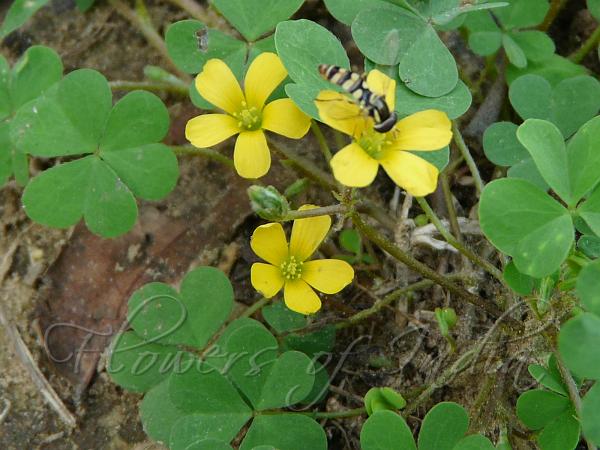|
| Creeping Wood Sorrel |
|

|

| File size | 961153 |
| Original date | 4/9/08 9:44 AM |
| Resolution | 2560 x 1920 |
| Flash | Flash did not fire, auto |
| Focal length | 9.0mm |
| Exposure time | 1/100s |
| Aperture | 3.2 |
| Focus Distance | |
| Metering Mode | Multi-segment |
| Camera make | Panasonic |
| Camera model | DMC-FZ18 |
| Sensor type | OneChipColorArea |
|
|
|
Photo: |
Botanical name: Oxalis corniculata Family: Oxalidaceae (Wood Sorrel Family)
Synonyms: Oxalis repens
Synonyms: Oxalis repens
Creeping wood sorrel is a world-wide weed which is almost impossible to get
rid of. So, one might as well enjoy it - it has beautiful yellow flowers.
Creeping woodsorrel is of uncertain origin just because it became so wide
spread so long ago. Branching from the
base and often rooted at the nodes, the upper portion is ascending or weakly
erect, smooth or hairy. The leaves are arranged alternately along the stems. A
single long stalk arises from the axils of the leaf, from which extend three
flower stalks, each with a single flower. The flowers are 7-11 mm wide and
have 5 yellow petals. The fruit is a capsule, 1-1.5 cm long, cylindric,
pointed apically, and 5-ridged in cross section. Creeping wood sorrel is
also found in the Himalayas, at altitudes of 300-3000 m.
Flowering: February-October.
Medicinal uses: Creeping Wood Sorrel is used in the treatment of influenza, fever,
urinary tract infections, enteritis, diarrhoea, traumatic injuries,
sprains and poisonous snake bites. The juice of the plant, mixed with butter,
is applied to muscular swellings, boils and pimples. An infusion can be
used as a wash to rid children of hookworms. The plant is a good source of
vitamin C and is used as an antiscorbutic in the treatment of scurvy.
The leaves are used as an antidote to poisoning by the seeds of Datura spp,
arsenic and mercury. The leaf juice is applied to insect bites, burns and
skin eruptions. It has an antibacterial activity.
Creeping Wood Sorrel is used in the treatment of influenza, fever,
urinary tract infections, enteritis, diarrhoea, traumatic injuries,
sprains and poisonous snake bites. The juice of the plant, mixed with butter,
is applied to muscular swellings, boils and pimples. An infusion can be
used as a wash to rid children of hookworms. The plant is a good source of
vitamin C and is used as an antiscorbutic in the treatment of scurvy.
The leaves are used as an antidote to poisoning by the seeds of Datura spp,
arsenic and mercury. The leaf juice is applied to insect bites, burns and
skin eruptions. It has an antibacterial activity.
Medicinal uses:
 Creeping Wood Sorrel is used in the treatment of influenza, fever,
urinary tract infections, enteritis, diarrhoea, traumatic injuries,
sprains and poisonous snake bites. The juice of the plant, mixed with butter,
is applied to muscular swellings, boils and pimples. An infusion can be
used as a wash to rid children of hookworms. The plant is a good source of
vitamin C and is used as an antiscorbutic in the treatment of scurvy.
The leaves are used as an antidote to poisoning by the seeds of Datura spp,
arsenic and mercury. The leaf juice is applied to insect bites, burns and
skin eruptions. It has an antibacterial activity.
Creeping Wood Sorrel is used in the treatment of influenza, fever,
urinary tract infections, enteritis, diarrhoea, traumatic injuries,
sprains and poisonous snake bites. The juice of the plant, mixed with butter,
is applied to muscular swellings, boils and pimples. An infusion can be
used as a wash to rid children of hookworms. The plant is a good source of
vitamin C and is used as an antiscorbutic in the treatment of scurvy.
The leaves are used as an antidote to poisoning by the seeds of Datura spp,
arsenic and mercury. The leaf juice is applied to insect bites, burns and
skin eruptions. It has an antibacterial activity.| Identification credit: Tabish | Photographed in Delhi & Gujarat. |
• Is this flower misidentified? If yes,